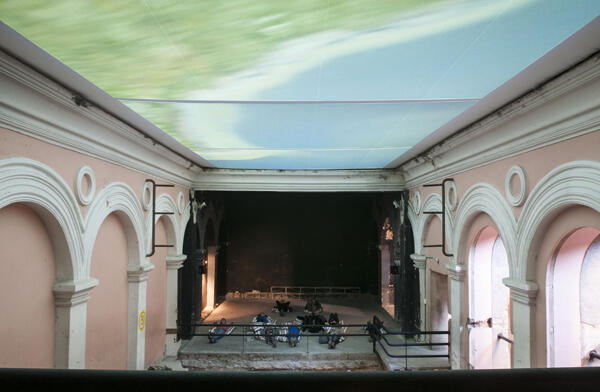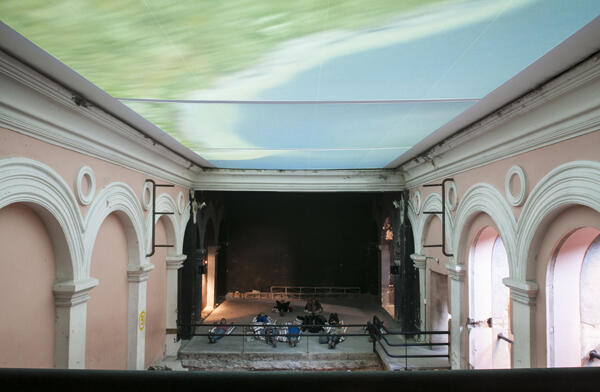Miler Lagos
Espacio Odeón, Bogotá
The scene Rompimiento de Gloria, in which a light source irrupts from behind some clouds, dominating the space and transforming it into a place for contemplation characteristic of the Baroque, provides the title for the exhibition presented by Miler Lagos at Espacio Odeón. Comprised of three video-installations and some photographs associated with the landscape, it rather suggests the relationship of human beings with it, and eventually results in an intense reflection on time.

The centerpiece of the exhibit is projected onto a canvas projection screen on the ceiling of the main auditorium of the former Odeón Theater, built in 1941 and conceived as a movie theater. The title, LAT 65.31N LONG 114.13W, marks the geographic position of the place from which the expedition to rescue Sir John Franklin, lost in the Canadian Arctic region, left in 1845. The aerial shots, constant throughout the video, involve an unusual gaze in terms of the traditional representations of the landscape, and seek “ an expansion of the scope of the visual experience that transforms the landscape into a sublime spectacle”, as the artist points out in the text that accompanies this work.
The second video, Kanipinikassikueu or Caribou Man, takes its name from a legend of the Innu natives. It tells the story of an Innu man, who decides to live with the caribou, marries a young caribou woman (a doe in the herd) and is turned into a caribou himself. In this way he becomes a supernatural being who will protect the Innu tribe and give them permission to hunt the caribou for food and even for other uses. This video features a single frame of an Inuksuk − a monument made of stones in the likeness of a human − against the light, adorned with some forms that appear to be caribou antlers, with small stones hanging from them and colliding as a result of the wind. This breeze affects only the stones and nothing else in the scene. The interest in the sound produced by the collision of the stones invokes the tacit ritual that this powerful image conveys, the absence and at the same time the presence of human beings in a land as inhospitable as the Canadian Arctic.
Last, Skipping Stones is a video in which a stone is cast into the water, bouncing several times on the surface before sinking, a pastime known in Latin America as hacer sapitos (stone skipping). The video shows an apparently static environment in which the stillness is interrupted by the sound of the stone hitting the water and altering its movement, in a framing that implies that it is the viewer that performs the action. Each one of these three videos featuring fixed, single frames invites us to contemplate the landscape around us, which is also fixed and unique, suggesting one of the possible ways of establishing a relationship with it, of using our time to observe the small changes that take place in it, as metaphors for our own existence.
-
 Photo Oscar Monsalve. Courtesy the artist.
Photo Oscar Monsalve. Courtesy the artist.
Vista de la video instalación en el Espacio Odeón / Fotografía Oscar Monsalve. Cortesía del artista.




